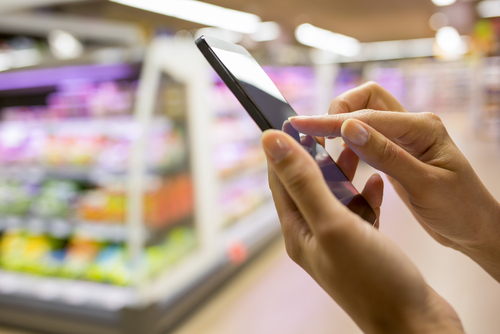The retail landscape is continually being shaped by the technology we use. Gone are the days when the customer journey was a linear process, with one step logically following another to the point of purchase.
Instead, today’s customers use digital platforms to make informed choices about what to buy or share their experiences with others.
Increasingly, this activity takes place while they are on the move – which makes mobile technology one of the most important drivers behind this change.
Today, 63% of adults use a smart phone and more than 50% of the UK’s e-commerce traffic comes from mobile.
>See also: Consumers are disappointed in retail mobile apps: here’s how to fix it
People are no longer just online when they are at home or work; instead they manage their whole digital lives from a mobile device, whether it is communicating with friends and family, accessing social media, listening to music, making payments and, of course, shopping.
Armed with a smartphone, consumers have vast amounts of information at their fingertips but it can be difficult for brands to get their messages seen and heard. They have to shout louder to be heard above the noise.
Mobile is also one of the key disrupters in the traditional customer journey and this trend will continue as the technology becomes more sophisticated. Take, for example, the process of researching a product. Instead of simply buying goods in-store or online, consumers often spend time reading reviews, browsing a store’s website, checking stock levels, finding the nearest branch, searching for discount vouchers and comparing prices against competitors.
Of course, people can carry out this kind of research at any time and in any location, from the comfort of their sofa or during their commute to work. It might also involve ‘showrooming’ where shoppers browse a bricks-and-mortar store, comparing the products on display with ones online using their mobile.
They might try them out, or ask the sales team for a demonstration, before buying the same model online at a cheaper price.
While this might make the buying process appear a lot more complicated than it once was, it is important for brands to remember that consumers do not want to be bombarded with information nor have to remember endless passwords.
They want streamlined experiences with everything they need to make a purchase in one place and if a company does not offer this then chances are they will move to one of their competitors.
Mobile technology places power firmly at the hands of the consumer – but it also opens up exciting opportunities for brands to communicate their messages in real time. This phenomenon is already common in the Asian market, with messenger apps such as KakaoTalk in South Korea and Line in Japan offering live chat and payment facilities.
Last year saw the launch of Facebook’s messenger app for business, which can be used to send personalised order updates, delivery information and answer any customer enquiries. Although it is only available to a selected number of US businesses at the moment, it is expected to eventually be rolled out across the board.
This is a commonsense move because it gives customers the convenience of being able to store all their transactional information from multiple brands in one place. Many companies have a chat function on their website but Facebook is a platform already used by millions of people each day so there is huge potential to interact with a wider audience.
Thanks to the launch of Apple Pay and Android Pay last year, more people than ever are using their mobile to pay for goods in store. Credit and debit cards can now be linked to a device to create a ‘digital wallet’ that can interact with payment terminals in a store. Despite some concerns over safety and security, the move was met with little opposition highlighting the trust and confidence that consumers have in mobile.
>See also: How mobile technology is disrupting retail
The infrastructure that supports mobile payment is simple: most smart phones are now enabled with NFC (near field communication) technology that allows data to be transferred between two nearby devices.
As well as contactless payments, NFC can also be used to promote customer engagement in stores, with discount coupons, special offers and loyalty cards all contained in the convenience of a smart phone.
This means all payment and loyalty activity is linked directly to the customer as soon as a transaction is made. For shoppers, this creates a seamless experience, but it is also highly beneficial for retailers who can foster loyalty and collect data to drive in-store behaviours and engagement– all in real time.
Sourced from Barry Smith, Ikano Insight










